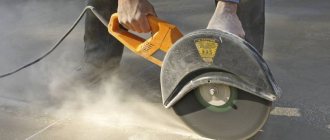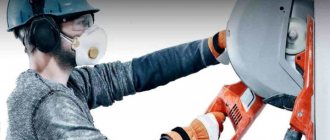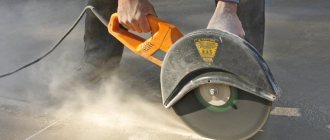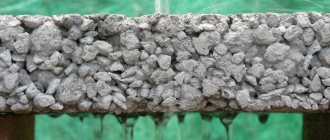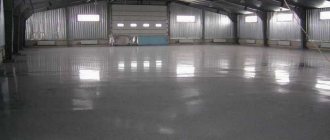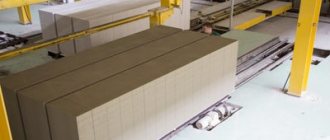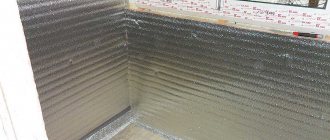During the construction process, there is often a need to drill holes in a concrete wall to change or create openings for doors, windows or communications. For these purposes, concrete is cut using a variety of equipment, from hand tools to heavy professional machines.
However, it is worth considering that drilling walls involves a huge amount of dust and noise. Therefore, before starting work, we will consider methods for cutting monolithic surfaces.
Concrete cutting methods
Concrete cutting involves chipping, drilling, crushing and grinding. According to the method of performing work, there are two methods:
- Dry. In this case, work is carried out with breaks, which are necessary for the equipment to cool down. In addition, when dry cutting concrete walls, you will have to use a special vacuum cleaner or wait until the dust settles (due to the volume of dust, you simply will not see the cut site). Another disadvantage of this method is the small depth to which the cutting apparatus can be immersed. Due to strong lateral friction, the disc will become very hot and fail faster.
- Wet. This dust-free cutting method is considered the most correct and less labor-intensive, since you do not have to wait for the equipment to cool down. The water supplied to the cutting wheel performs several functions at once: it cools the cutting tool and “beats” dust.
To produce high-quality and fast cutting of concrete without dust, it is recommended to use the wet processing method. To perform this type of work, various diamond-coated tools are used.
You've almost drilled to the required depth and you can't go any further.
In practice, this means, for example, for a depth of 5 cm you underdrilled 5 mm. Then you hit something. There are very rare cases when you come up against something serious, for example, some hard solid cobblestone that cannot be drilled or crushed using any method.
If the screw on which you are going to hang the structure does not have strict load requirements, then try to take the same screw, but 5 mm shorter, and the dowel that is not fully inserted into the hole and sticks out with its small end, simply cut it with a construction knife, as shown in the picture:
Next, just take a screw that is 5 mm shorter and screw it into the trimmed dowel. This is not a very good practice, but from time to time there are situations when nothing else can be done and this is the way out!
Tools
Today, cutting openings in concrete is carried out using the following units:
Hand carvers
Such equipment for cutting concrete is most often called a “grinder”, but in the professional sphere this device is called an angle grinder (angle grinder). This manual cutter allows you to make openings up to 13 cm thick in the wall. Tools of this type can have different powers, and they are also equipped with special attachments that are fixed to the grinder using a screw thread. Most often, cutting is performed using grinding, roughing and cutting diamond discs.
Healthy! When choosing diamond cutting discs, it is recommended to buy products with cutouts for ordinary concrete and without cutouts if you plan to cut reinforced concrete structures, since the protruding elements of the disc will cling to the reinforcement.
Hand cutters have high maneuverability, thanks to which work is carried out in large volumes. On the other hand, grinders and diamond discs for concrete are suitable only for small areas. If you use such equipment for large construction projects, you or your workers will quickly get tired.
Wall sawing machines
A wall saw is another concrete cutting tool that is equipped with a diamond blade. The unit consists of a motor, a hydraulic pump station, guide rails (for vertical and horizontal fixation), a cutting disk (with a diameter of more than 25 cm) and a control panel.
This type of machine provides higher cutting quality. In addition, the unit has the following advantages:
- The depth of the opening can reach up to 7.5 cm.
- Suitable for voluminous work of increased complexity.
- With the help of the unit, reinforced concrete is cut as quickly as possible.
- Low noise and vibration levels.
- Reliable fixation on the surface being treated.
Among the minuses it is worth highlighting:
- High cost of concrete cutting machine.
- To use the unit you must undergo training.
- Requires 380 W power supply.
Seam cutters (seam cutters)
Seam cutters are often used to cut horizontal concrete floor slabs and create expansion joints and openings. The joint cutter consists of a metal frame on wheels, an engine and a cutting wheel. Using this equipment, openings up to 2.7 cm deep can be cut.
There are seam cutters:
- Stationary. Devices of this type are used for thick layers of monolith.
- Portable. Such units allow you to make cuts of different depths and configurations.
Among the advantages of this equipment is the ability to cut thick surfaces with minimal vibration. Among the disadvantages, it is worth highlighting the high cost and the ability to process exclusively horizontal surfaces.
Rope machines (cutter)
Rope machines are available with both hydraulic and electric drives. Also, devices of this type are equipped with oil stations, rope racks, rollers and cooling systems.
Rope cutting of concrete is used for dismantling large buildings (bridges, piers, columns and much more). Such a specialized cutter is capable of making holes up to 50 cm deep. Cuts are made in any direction.
The main cutting element in such machines is a special rope coated with diamond coating.
This type of equipment is considered expensive and difficult to operate, so rope machines are used for various jobs (dismantling, cutting reinforced concrete, blocks and pipes) on large construction sites.
However, making cuts with a grinder or wall saws is not always possible due to the lack of electricity. In this case, a concrete chainsaw or, as it is also called, a gas cutter, is used.
Concrete cutting saws
For manual cutting of concrete, a concrete chain saw powered by gasoline or compressed air is often used. This lightweight and affordable tool does not require any special skills, so it is ideal for DIY construction work.
A chain cutter differs from a chainsaw for wood in that it has a more complex bar, which is equipped with special channels for water supply (due to which concrete is cut without dust) and a diamond chain.
This cutting set allows you to make cuts up to 30-40 cm deep, while the unit rotates 90 degrees, which is very convenient when creating niches, openings and other holes in concrete.
As a rule, gas cutters operate on a push-pull principle and are characterized by a high degree of protection against dust formation.
The concrete cutting saw is suitable for the following materials:
- Lightweight concrete (expanded clay concrete, wood concrete and other materials).
- Heavy concrete, which includes Portland cement, asphalt and other binders. You can also use a gas cutter to process monoliths if there is a weak reinforced frame.
- Silicate and ceramic bricks.
- Natural stones, porcelain stoneware and other artificial materials.
- Gypsum, plasterboard and limestone structures.
The gas cutter is also suitable for working on foam concrete and other cellular concrete (foam blocks, gas blocks, foam-gas concrete blocks and others).
Also today there is:
- Laser cutting of concrete. The treatment is carried out by heating the surface with a laser. Due to the high cost of equipment, such processing is now practically not used.
- Plasma cutting of concrete. This method is also never used in private construction, but the cost of the equipment is lower. For plasma cutting, the material is also heated, but not by the laser, but by the compressed plasma arc.
Once you have decided how to cut concrete, you need to take into account several nuances of the work.
Cutting tiles
Sometimes it becomes necessary to shorten a standard concrete slab at home without having power tools.
Here you will have to work manually. For this:
- mark a line with a pencil on both sides;
- split concrete with a scarpel and a hammer;
- A chisel and a hacksaw will help you deal with the reinforcement.
With this method, on one side the edge turns out to be uneven. This end is laid against the wall, and subsequently it is covered with a plinth.
Features and procedure for cutting concrete
Before cutting concrete, you need to determine the type of building material, especially if you are using an angle grinder with a disc. Therefore, first check the thickness of the surface to be treated. If the cutting depth is about 10 cm or more, then the diamond wheel for concrete will most likely bump into the reinforcement, so you need to choose more durable cutting discs.
Also consider the following recommendations:
- Basalt and quartz quickly dull the disk.
- The larger the fraction of filler in the concrete slab, the slower the cutting will be.
- The smaller the hand cutting tool, the less power it will have.
- For fresh and hard material, you need to use different concrete cutting discs.
- Before starting work, it is necessary to make a test cut, no more than 1 cm deep. This is necessary in order to evaluate the operation of the equipment.
- When performing dry cutting, remove the blade from the unit between cuts to cool it faster.
- When using any equipment, be sure to wear a protective respirator mask, goggles and gloves.
- For perfectly smooth, round holes in concrete, use special diamond core bits.
After preparing and checking your equipment, follow these simple steps:
- Mark the line along which the cut will be made. To make your work easier, secure wooden blocks along the cutting line. Thanks to this, the disk or saw will not “carry” from side to side and you will not accidentally make a cut deeper than necessary.
- Turn on the equipment and make a test cut.
- Continue working, immersing the equipment to the desired depth (remove the bars).
General recommendations
Drilling load-bearing walls and partitions made of concrete is not an easy task. To complete the intended work quickly and efficiently, you need to know some secrets and tricks. It also doesn’t hurt to listen to the views of the most experienced masters who recommend:
- Use a concrete drill to work with the same material, also with stone and ceramics. They are absolutely not suitable for metal and wood.
- Drill any iron reinforcement found in the wall using only a metal drill, then change it again to a concrete drill.
- Break hard stones in concrete manually using a sledgehammer or using an old drill for this purpose.
- Monitor the condition of the nozzle when working with hard concrete. It should not overheat, so it is necessary to take breaks in operation every 10 minutes.
- To maintain the integrity of the wall on the reverse side, it is necessary to slow down from time to time.
- You can drill clay tiles with a concrete drill, but you shouldn’t press the drill too hard, so as not to split the finishing material.
By following these tips, you can drill a hole in a concrete wall without any problems. In this way, you will be able to save not only time, but also your own energy.
Advantages of diamond coated blades
If an experienced builder is wondering which discs are best for cutting concrete, then the answer will be one – diamond.
Their advantages are obvious: a complete configuration with a machine without gaps (taking into account the correct selection for the dimensions of the machine). Universal ones have large teeth that increase the pressure on the material and the cutting speed.
The cutting speed and accuracy have already been mentioned. In addition to this, there is a long service life. If the concrete has reinforced structures, then it is better to use discs with laser welding and temperature control.
Joint cutter
One of the many concrete cutting devices is a joint cutter. This is a professional road construction equipment that is widely used for cutting concrete and asphalt.
But its main task is to cut expansion joints in concrete floors, hence the name of the unit.
They are also used for opening concrete and asphalt foundations and dismantling reinforced concrete floors. Convenient for cutting pit cuts.
These units operate on gasoline and diesel engines and are powered by 220 and 380 volts. They can be single-phase and three-phase, respectively.
The devices are equipped with devices that regulate the depth of the seam. Disc diameters from 350 to 1500 mm. The kit includes a tank for water supply.
Basic principles
A machine is used for cutting.
To cut concrete, you will need the following tools:
- machine;
- roulette;
- electric drill;
- drills with a diamond or pobedite tip;
- metalworking tools;
- level;
- individual protection means.
Partial slabs are produced by hand cutting. First, mark the location of the cut on the structure on both sides. The slab is cut using a hammer and a scarpel. To deal with the reinforcement, use a chisel. Partial slabs, when cut by hand, have one uneven side.
When facing, the slabs are placed with the uneven side to the wall, so that the deformed edge is then covered with a plinth. Chopped (incomplete) tiles are laid on the smaller side of the room near the wall area.
Rows of incomplete tiles can be laid only from the entrance to the room and in places that in the future will be filled with household appliances or furniture.
House made of gas silicate blocks. Features of installation of floor slabs. How to glue foam to concrete? More details>>
How to coordinate openings in load-bearing walls
The arrangement or expansion of openings in a concrete wall must be carried out in accordance with all standards and have permission from the relevant authority. When making a decision to carry out redevelopment, you need to take into account a number of indicators:
- The number of the floor on which the redevelopment work will be carried out (the load on the walls will be less, the higher the floor on which the apartment is located).
- What year was the house built?
- What is the width of the opening and where is it located (at the junction of the slabs, at what distance to the external walls).
- What condition are the walls in the room?
The redevelopment of an apartment can be entrusted to employees of organizations that have permission to carry out such construction work. Nowadays, very often owners remodel buildings and apartments, widen old openings in the walls, and install new ones.
- Diamond cutting is considered the leader in building dismantling work. The cutting elements are capable of cutting through a concrete wall whose thickness exceeds 60 cm.
- Cutting using the waterjet method is more environmentally friendly and safe.
- A good effect is obtained when using oxygen-lance drilling, however, certain training and experience are required to perform the work. You can get burned if you do not follow safety precautions when working.
Considering the thickness of the concrete walls in which you need to make or enlarge the opening, and also depending on the result you want to get, you can choose the cutting method that is more suitable for you.
The main thing, when carrying out work, do not forget that the changes that will occur in the load-bearing walls must be carefully calculated and approved by the appropriate authority, and the openings must be strengthened.
Video: How to Cut a Concrete Slab
Source
To save money, private developers can successfully use reclaimed building materials.
For example, this can be brick cleared of mortar, as well as various types of reinforced concrete products, which, of course, should not crack.
Today I want to tell you how I used old reinforced concrete supports that had been lying along a hedge for decades and had been blocking passage for a long time.
I decided to use them to build the foundation of a future bathhouse.
And the question immediately arose: how and how to trim them to the size of the future structure.
After much thought and trying to use sledgehammers and hammer drills for this purpose, I chose special discs for grinding machines.
But on the first attempt to cut the column, the abrasive disc fell apart. Apparently, the distortion was gone, fortunately, the grinder had a protective coating, and there was also a mask to protect the head and face.
After that I installed a Stern Turbo modified diamond coated metal disc. It was much more fun, cutting concrete like butter, but there was so much dust that I had to stop working to protect my respiratory system with a woman's scarf folded in three. The Lepestki protective respirator purchased on the market did not produce any results. Also, the narrow glasses were very helpful.
READ Cut Lavash into Strips with Scissors
After the disk reached the armature, sparks began to fill. According to the manufacturer, this blade can also cut metal, but I thought it would be a good idea to save money and continued to cut the column without touching the metal.
I then cut the support next to the previous cut to the width needed to hit it with a small sledgehammer.
After hitting the end of the strip, the concrete block flew away in the form of a neat planed board, revealing the reinforcement of the work done.
This made it possible to cut it with a cheap metal cutting wheel.
It should be noted that cutting the fittings was very difficult. The cement layer of the metal made itself felt, as well as the pre-tensioning of the reinforcement during the manufacture of the support. But the abrasive cutting disc completely coped with this task.
After one side of the support was machined, I flipped it over with the gap, supports and neighbor on the opposite side, and then placed a block of wood under the intended gap to weigh the cutout area.
After this he repeated the above operation exactly, and after I had removed the last fitting, the post broke and broke in the right place. The buttocks turned out to be neat and smooth.
We moved the cut part of the reinforced concrete support into the trench of the future foundation using a crowbar and four pieces of old pipes.
Finally, I would like to give some tips to those who want to cut reinforced concrete.
1. If you just need to cut fittings, you don't need to waste energy and money, it's better to borrow https://www.Dortexkom.Ru/catalog/razdel-140.Html. If you are constantly working with fittings, then you should choose a machine like this and you will always win.
2. Use diamond blades to cut reinforced concrete. They allow cutting concrete both water-cooled and dry. Accessories can also be cut with these circles, but I was sorry to waste them on metal.
3. IMPORTANT! Take care of personal protective equipment in advance (safety glasses, durable gloves, a good respirator and mask). You can even take a gas mask.
3. Prepare reliable auxiliary tools (crowbar, pipes).
4. Work on cutting reinforced concrete does not tolerate fuss, so no time is wasted.
Source
- Building blocks
- Construction boards
- Mortar
- Construction Lessons
How to cut a concrete slab. How to cut concrete. All about concrete
Laying walls from expanded clay concrete blocks: methods and rules
Expanded clay concrete blocks have been used for construction for more than half a century.
Laying walls from expanded clay concrete blocks is not very difficult and can be done with your own hands, especially if you have the skills to lay bricks or blocks from other materials.
But at the same time, it is necessary to take into account all the features of the material and follow the rules that we will consider in this article.
Expanded clay concrete blocks as a building material
Scope of application of expanded clay concrete
The selection of expanded clay concrete blocks is important depending on the area in which they will be used.
Solid or monolithic blocks are used to form the foundation, when constructing load-bearing walls and floors.
Hollow blocks are most often used for the construction of non-residential premises or low-rise buildings. The thermal insulation properties of such a material make the material very popular.
Construction of a house from expanded clay concrete blocks
Thickness and types of seams
The thickness of the seams between blocks and rows should be within 6-8 mm, but not more than 10 mm. The smaller the seams, the more flexible the solution should be. When using adhesive mixtures as masonry mortar, the thickness of the joints can be reduced to 3 mm.
READ Chain lubrication for Huter VS45 chainsaw
Masonry of expanded clay concrete blocks can be carried out with full filling of the joints - undercutting, when the excess mortar is cut off with a trowel, or with incomplete filling of the joints - emptying, when the seam remains unfilled with mortar by 5-6 mm.
The second method is usually used if, after masonry, the wall surface will be plastered on this side.
Reinforcement
One of the features of the work technology is that simultaneously masonry of both external and internal walls or partitions from expanded clay concrete is carried out. This is necessary in order to reinforce the masonry with reinforcement at the same level along the entire perimeter of the building.
As already mentioned, such reinforcement is performed every 3-5 rows with reinforcement with a diameter of 8-10 mm. The reinforcement is placed in grooves cut using a grinder or in longitudinal grooves already existing in some blocks. Sometimes mesh is used instead of reinforcement for reinforcement.
It can be used only if the masonry is carried out without internal insulation in the form of slabs.
Masonry at the junction of external and internal walls must also be carried out with ligation of blocks: the blocks of the internal wall must go into the external wall, through a row. To prevent the formation of “cold bridges” in this place, the ends of the approaching blocks can be insulated using pieces of insulation, such as polystyrene foam.
The technology for laying multi-slot expanded clay concrete blocks with transverse placement of slots is different in that it is carried out only in bonded rows - the blocks are laid with the long side across the wall, with the blocks tied in the rows.
Individual protection means
Before cutting concrete, you must wear at least a professional respirator, not only when it’s dry, but also when it’s wet. The fine dust particles generated during concrete cutting can penetrate deep into the lungs and lead to very serious health effects such as silicosis or lung cancer. If there is a large amount of work to be done, you need to additionally use other means: headphones, glasses, gloves and special protective clothing.
If you are not sure that you can cut concrete yourself, it is better to invite a professional to do it.
